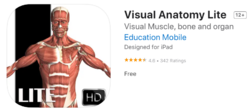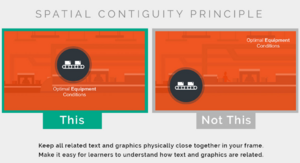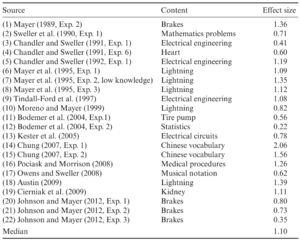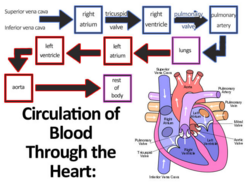Spatial Contiguity Principle
Overview[edit | edit source]
Students learn better when corresponding words and pictures are presented near each other than far from each other on the page or screen(Mayer et al. 1989).
As one of Mayer's 12 Principles of Multimedia Learning, the Spatial Contiguity Principle refers to a close together distance in the actual space between relevant text and visuals on the screen. When the corresponding words and pictures are far from each other, we define it as separated presentation. Spatial contiguity is created when we use an integrated presentation in which each illustration is placed next to the text that describes it, and words have been inserted into the illustration. By this, Learners have cues for combining corresponding words and images that save their working memory during cognitive processing. This principle is important to consider when developing e-learning modules because it allows for meaningful learning by creating a mental connection between words and images.
Evidence[edit | edit source]
Placing printed words near the graphics they describe to guide the learner's cognitive processing helps to reduce extraneous processing.
There are 22 tests of the spatial contiguity principle in the research(Table 12.7). For example, in Mayer's study(1989), students trad a paper-based lesson on how brakes work and then need to take a transfer test. Some of the students(Integrated group) were provided with words describing the action and were placed next to the corresponding part of an illustration. Others(Separated groups) received each picture that was placed at the top of a page and the corresponding words were separated and placed in a paragraph at the bottom of the page. The result shows that the integrated group performed much better than the separated group on a transfer test.
The spatial contiguity principle represents a subset of what Ayres and Sweller call the split-attention principle. The split-attention principle refers to 'avoiding formats that require learners to split their attention between, and mentally integrate, multiple sources of information.'
Four Possible Boundry Conditions[edit | edit source]
'The spatial contiguity principle has four possible boundary conditions: low prior knowledge, nonredundant text and images, complex lessons, and interactive formats. '
Low Prior Knowledge
Mayer and colleagues discovered in 1995 that integrated presentations were more effective than separate presentations for low-priority knowledge learners but not for high-priority knowledge learners, supporting the expertise reversal principle.
nonredundant text and pictures
According to Ayres and Sweller, the spatial contiguity principle is most useful when multiple sources of information would be incomprehensible in isolation. It makes no difference if the words are presented in a separated format if they are not required to understand the graphic.
Complex Lessons
Ayres and Sweeler also stated that the spatial contiguity principle applies when the material is complex, but may not apply when the material is so simple that separated design does not overload the cognitive system.
Interactive Formats
Some evidence suggests that the spatial contiguity principle can be strengthened when learners create integrated presentations by moving text to relevant portions of a graphic on tire pumps, according to studies conducted by Bodemer and colleagues in 2004.
Implication Guidelines[edit | edit source]
Pop-Up Windows
- Make sure questions and corresponding answers are placed on the same page
- Do not use multiple tabs, and use linked windows so that readers can see the answers to posing questions without scrolling over various pages or tabs
Text and Animations
- Use animation formats' materials to provide readers with a visual representation of the context
- Display text and animations together
- Need to have a 'Play' bottom to control the animation as the text is a still present
Too Much Text and Rool Over Effect
- Too much text can overwhelm the readers and make the content to be less visually appealing for readers
- When the cursor is hovering over the corresponding graphics, the Roll Over or Mouse Over effect displays the same information because it is displayed in a pop-up type message.
Design Implication[edit | edit source]


Use Diagram to Introduce Our Brain[edit | edit source]
On the left diagram, the letter and the terms are separated from each other while on the right one the terms are directly linked to the corresponding part of the image. The right diagram is more useful that helping the learners to remember and shape the connection between information.
Contiguity Principle in VisAnatomyLite[edit | edit source]
This app employs 3D diagrams of various body parts, and when you click a specific area on the diagram, the correct term appears. This is an excellent example of The Contiguity Principle in action because it displays both images and text while ensuring that the corresponding words are linked to the images.
Circulation of Blood[edit | edit source]
In the picture, both images show the circulation of blood through the heart. They together convey the concept of what the heart organs look like and the order in which blood goes through each organ in the heart. If it only has one representation, the learner will miss the opportunity and be unable to know either the structure of the heart or the workflow of the blood.
The benefit of each separately is to clearly know the focus and the topic of the representation. The benefit of both together is that the right image of the heart helps the learner to better understand the flow of blood in the left image. The learner can construct the mental image of how the blood goes into an actual heart and comprehend the knowledge. It uses the duo-coding theory to provide both verbal and non-verbal information from sensories into learners’ memory, which leads a higher learning efficiency.
The problem with having both representations is a lack of spatial contiguity. The order phrases are connected with the arrows but are not linked with the image together, which causes an extraneous load for the learner to encode the knowledge.
Reference[edit | edit source]
Mayer’s 12 Principles of Multimedia Learning: Introduction. (n.d.-b). https://www.skillsandparticipation.co.uk/mod/book/view.php?id=11085
Clark, R. C., & Mayer, R. E. (2016). E-Learning and the science of instruction: Proven guidelines for consumers and designers of multimedia learning.
Visual Anatomy Lite. (n.d.). https://apps.apple.com/ca/app/visual-anatomy-lite/id523422151
Alessandra Marini. (2018, October 18). The Contiguity Principle. YouTube. https://www.youtube.com/watch?v=IPvfYLnihHc



